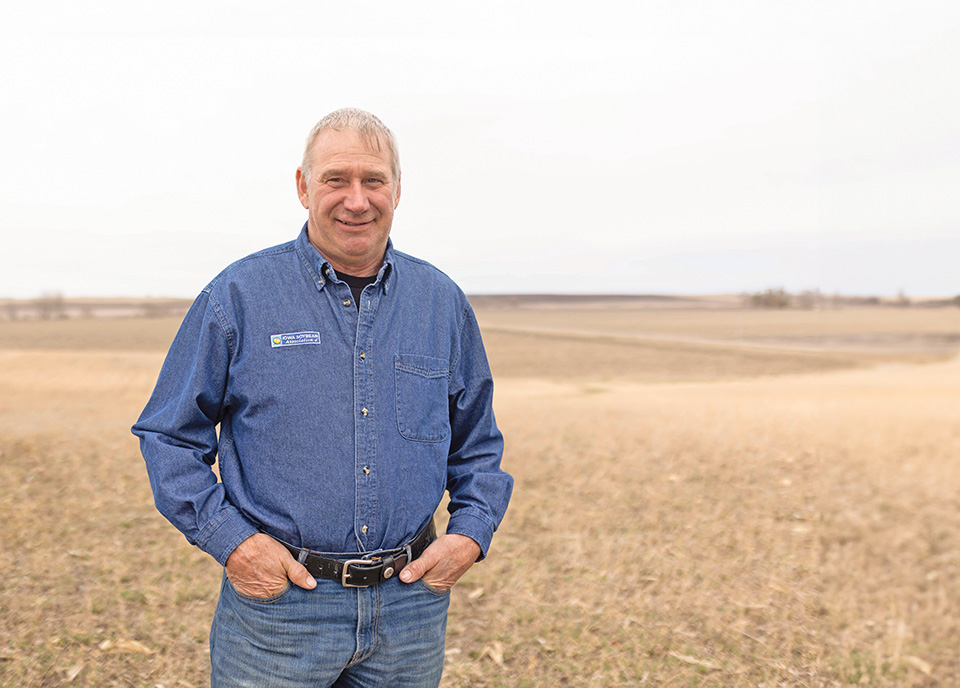
(Photo: Iowa Soybean Association / Joclyn Bushman)
Data offers a baseline for farmers
December 1, 2023
The rock ’n roll group Talking Heads once sang “Facts all come with points of view; facts don’t do what I want them to.”
The same could be said for data — those facts and statistics compiled for analysis.
But data out in the farm fields are a critical piece of the puzzle when it comes to profitability and production success.
An opportunity for farmers
Iowa Soybean Association (ISA) Conservation Agronomist Evan Brehm says data will always be a key component to those who make their living in the soybean fields of Iowa.
“Data from an agronomist perspective is very valuable in understanding what’s going on in the field,” he says. “Whether it’s the variety of seed, yields, nitrogen levels, water quality testing to see how we manage nitrogen run-off, data has meaning.”
For Brehm, data means an opportunity for farmers.
“It’s the bulk of how we can make agronomic decisions for farmers,” he says. “It helps with the overall return on investment and helps us continue to grow high-yield crops and make good agronomic decisions.”
Whether it’s soil testing, checking for moisture run-off, cover crop trials or input sources, gathering data is paramount in making decisions that will hopefully have a positive impact on a farmer’s bottom line.
“The more data, the more years of information, the better,” Brehm says. “We base our findings on research whether it’s from an association like ISA, university studies or other reputable sources, so we can compare it to what’s going on in the field.”
Soil testing, for example, is reliant on good data.
“How much fertilizer, weather, the overall environment; what does that mean for that farmer and his fields?” he says. “Data helps us with recommendations so we can focus on the farmer’s goals.”
But data is not equal. Every farmer and every field are different.
“Data should not be a blanket approach,” Brehm says.
Interpretation
That also means data is not foolproof.
It’s important to note that a farmer and his or her agronomist can have many years’ worth of data and the forecast projects a bumper crop.
Throw in unpredictable weather like extreme heat and a lack of moisture, and those yield numbers might plummet.
“Year to year, it can definitely vary, but it’s still important to have that baseline,” Brehm says. “Every year it can fluctuate, but farmers understand that.”
Brehm says he starts with the data, no matter if he’s working with a farmer, a cooperative, other ag retailers or processors.
“It’s a starting point,” he says. “Seed selection, nitrate levels, herbicides and pesticides, best usage — I’m mindful, even empathetic in what I share. You have to know your audience.”
But data can be interpreted differently by different people.
“Things can be taken out of context pretty quickly,” says Brehm. Having qualified people advocating for agriculture and conservation, in-field management, markets and continuing to relay those critical numbers properly is important.
“I’ve presented data to mixed audiences — non-farm and farmers — keeping those facts straight and explaining what the data means.”
Osceola area farmer Matt Diehl says data plays an important role in his farming operation.
The data he’s gathered over the past 2-3 years and used to improve his farming operation on everything from seed to cover crops has resulted in “phenomenal yields.”
ISA District 4 Director Marty Danzer says implementing data is critical to his Carroll County farm.
“We use technology through our local co-op,” he says. “It helps us with our fertilizer needs and our corn and soybean hybrids to adapt to different soil types.”
When he was farming 40 years ago, Danzer says data was a foreign concept.
“There was no data,” he laughs. “Everything we did was written out on a piece of paper; everything was done by hand.”
But technology and the recognition today that data has an important role to play in everything from seed selection, herbicides, manure usage and more, means success in the future.
“Every year is different, but the data we collect basically gives you a guideline to follow,” Danzer says.
Return on investment
The bottom line when it comes to making decisions based on data is that it also has to make economic sense.
“Regardless of what the data indicates, farming is a business,” Brehm says. “If they’re not making money, they’re not going to stay in business.
“I would rather be more profitable on 300 acres than farm 3,000 acres and barely make it — that’s where data can come into play.”
Back